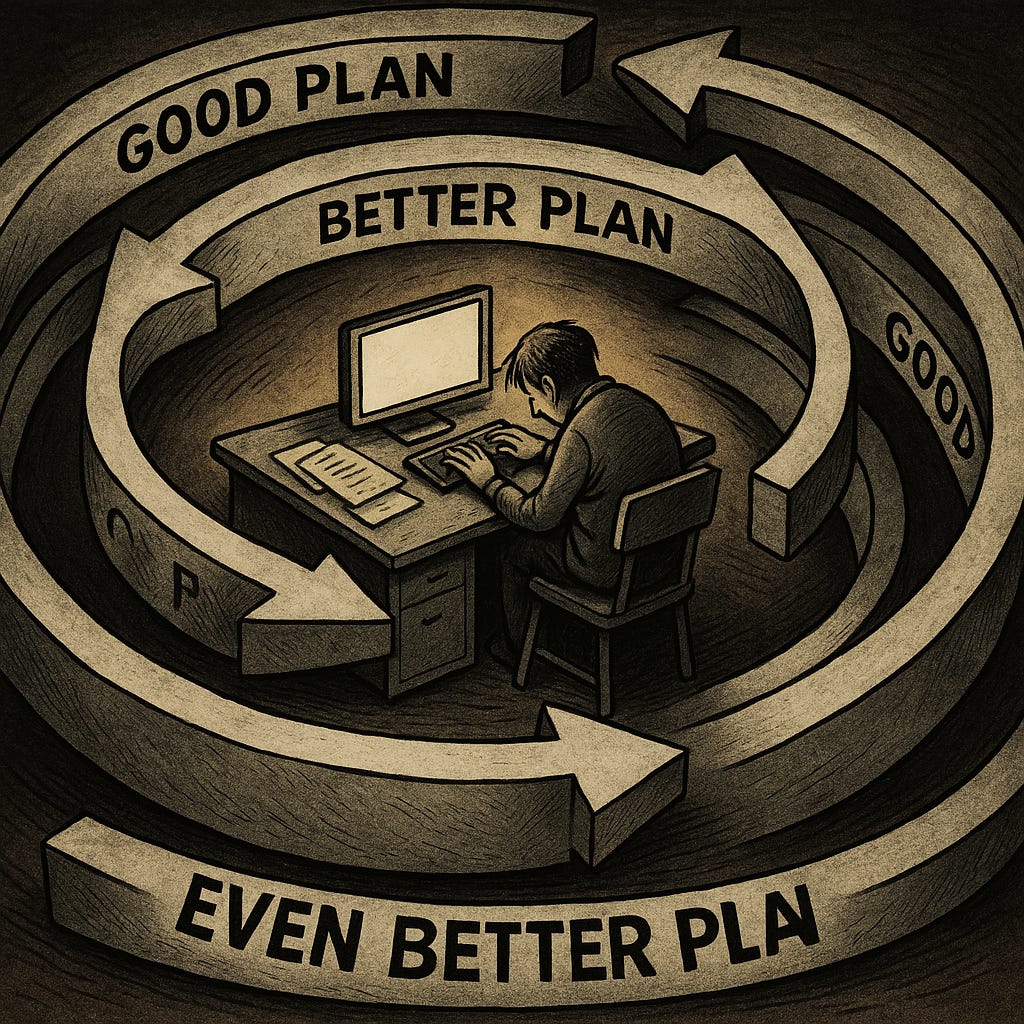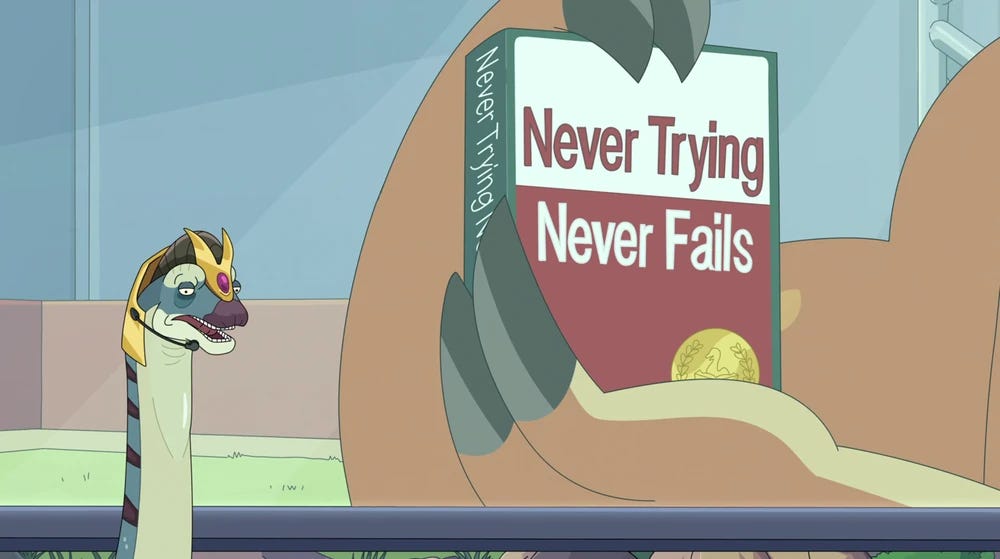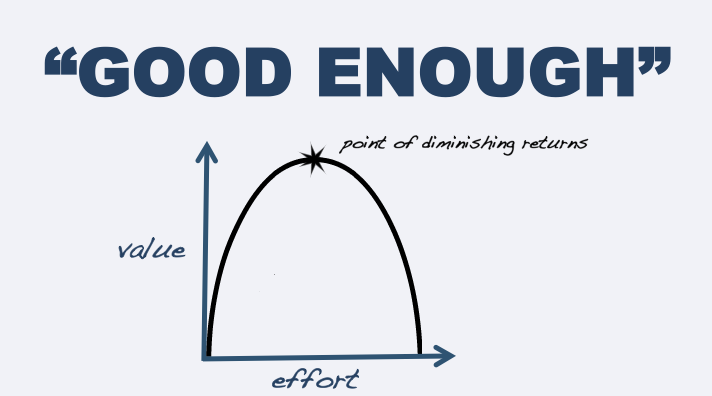Promptcrastination: Always Planning Never Fails
The dangers of sharpening your procrastination skills with Generative AI
After a quick burst of first 4 posts on this blog, I had a "big idea" - too big to fit into a single post. It needed to be planned as a multi-post series, and so began my tumbling into the eternal procrastination trap: Each new iteration felt exhilarating, glowed with fresh potential. The problem was, stuck in this revision loop, I wasn't actually writing anything1.
For a second there I thought I had coined a great term, plancrastination, to describe the specific flavor of procrastination that involves engaging with your task thoroughly via planning it, hence getting the dopamine hit, while staying safely outside the realm of execution. Yeah, right.
If You Never Start, You're Perfectly Safe
By now, you've surely been exposed to enough amount of motivational short form video to know that procrastination is mainly a symptom of inability to leave the safety of "ideas sanctuary" and venture to embedded probabilities of IRL.
Jerry Smith's world-famous book in Juristic Mort, Never Trying Never Fails, is the perfect first order explanation of this, and Jerry himself personifies this uncannily, whether when he "keeps crawling and it seemed to be working" or when he prefers to stay hidden in a hole when their couple therapy goes awry.
But what happens when we do venture out - just not quite far enough?
That's when the second order procrastination sneaks in: we stroll into the sanctuary's garden, from where we can see the real world and visualize the possibilities, without actually going there and building anything. Planning stops being a leverage for better outcomes, and becomes the very enabler of not starting. Enter: Plancrastination.
The Allure of Infinite Blueprints
So how do generative AI and chatbots play into this?
Anyone who dabbled in using chatbots to develop plans will tell you: they're the best brainstorming partner ever.
Yet by exponentially increasing the perceived grandeur of potential outcomes with their analytic approach and inexhaustible "yes, and" attitude, they are also the asymptotic lethal injection to any project a procrastinator intends to work on - always getting closer, but never arriving, to the destination that is "just doing it".
So promptcrastination is when plancrastination went to the generative AI gym and benched 220 on ChatGPT. It’s planning improvement ad infinitum, powered by an AI that never says "good enough."2
A Metric to Disprove Jerry
And more capable AI tools don't seem to be helping either, not yet anyways.
Yes, LinkedIn and X are buzzing with the "agentic-workflow-du-jour", whether it is a SaaS app built by Replit Agent in 10 minutes, or a presentation Gamma prepares for you in a jiffy. At the same time, the number of non-technical people around me who dabbled in multiple projects using no-code AI development tools or agents but ultimately gave up after Nth prompt is steadily increasing.
The procrastinators among them, who had seen an execution light at the end of the planning tunnel, ventured into the dangerous world of possibilities, yet discovered limited execution capabilities, are unlikely to return to action for a while. Like the Turkish proverb, “he who burnt his mouth with milk, blows on yogurt before eating it”.
So in the same vein as Citadel publishing adversaries defeated by Rick or # of not-filed job applications to parallel-universe Jerry professions metrics, I wish Replit published some of their growth metrics, not for the sake of investors, but psychologists and sociologists. We could see the actual number of working apps deployed go up and appreciate the technology's societal value, while also gauging the human toll of failed execution in the number of non-technical users churned, or the ratio of # projects working / # projects attempted.
The Medium Is The Message
There's also a McLuhan-esque dimension here.
Ivan Goncharov's Oblomov needed 150 pages just to contemplate getting out of bed, but at least he was constrained by 19th-century technology. We are armed with much more devious tools that enable us to stay in the metaphorical bed for another 100 pages.
Transformer-based LLMs specialize in text (and can dabble in images or code), but they're still generating representations. Real-world outcomes require physical or at least externalized execution: a tangible piece of software that runs, a product that ships, a building that stands.
The chatbot can simulate that future, but it can't forcibly drag you there. Why is that?
Maybe it's because they're not physically here with us yet, and once they take physical form, they will indeed nudge us to action (hopefully not too forcefully!). Ultimately, it is a fact that no one will save you.
It could be because their training corpus doesn't contain enough documents that abruptly ends with a "we stopped refining here and went IRL beast mode".
More likely, during their RLHF there was no answer option for the raters to indicate preferences for an AI that refuses to do more until human-in-the-loop hauls ass.
Right now, no proxy indicator in the world, about correctness of text, or syntax of the code, or sheer polish of writing, will tell us when IRL mode should kick in. LLMs might produce "working" code in a window, but we are still the ones to decide when to act IRL: to deploy and monitor it at scale, assess if it truly meets user needs, and close the feedback loop.
Ask Your Chatbot to Remember to Push Back
So perhaps the next time you find yourself refining that plan for the hundredth time, maybe it's worth a small chuckle at the Jerry in all of us. But more importantly, consider adding a nudge to your system prompt (a.k.a. custom instructions) asking the LLM to consider stopping the refinement and to bluntly let you know that it is time to stop planning and start the messy Rick-style process of doing.
Here’s something to paste into an ongoing long brainstorming conversation, to get some feedback on whether you’ve been a victim to promptcrastination too much, and to get you started on nudging your chatbot to remember this bias-to-action preference. Copy paste away!
1) Please review the conversation so far and point out where I might
have been over-optimizing or circling back unnecessarily.
Briefly note any patterns or repeated themes that could indicate
I'm stuck in excessive planning.
2) Going forward, keep a memory of my tendency to focus on
planning instead of action. If you see me repeating the same
details or requesting endless refinements, give me a brief nudge.
Something like: “I notice we’re revisiting the same points. Are
you ready to move on to implementation?” Comparing myself to Tim Urban and his 6-year long adventure to write a blog post that ended up being a book only gave more ammunition to the plancrastinator in me.
A friend pointed out that Y axis is incremental effort, which is misleading. Since I haven’t made the graph myself and instead found it on the web image searching for “good enough”, a good enough representation of “good enough” was good to post with. I obviously hadn’t thought this hard, but the unintended pun was too good to pass. Hence this footnote.






